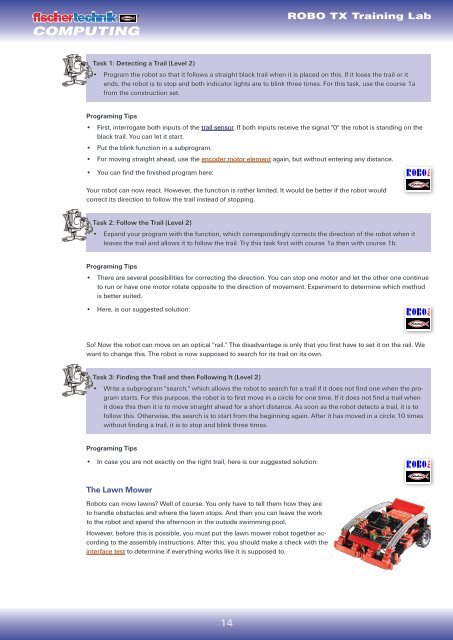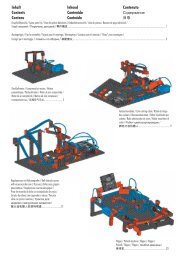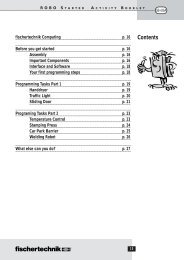computing - Fischertechnik
computing - Fischertechnik
computing - Fischertechnik
You also want an ePaper? Increase the reach of your titles
YUMPU automatically turns print PDFs into web optimized ePapers that Google loves.
COMPUTING<br />
Task 1: Detecting a Trail (Level 2)<br />
14<br />
ROBO TX Training Lab<br />
• Program the robot so that it follows a straight black trail when it is placed on this. If it loses the trail or it<br />
ends, the robot is to stop and both indicator lights are to blink three times. For this task, use the course 1a<br />
from the construction set.<br />
Programing Tips<br />
• First, interrogate both inputs of the trail sensor. If both inputs receive the signal "0" the robot is standing on the<br />
black trail. You can let it start.<br />
• Put the blink function in a subprogram.<br />
• For moving straight ahead, use the encoder motor element again, but without entering any distance.<br />
•<br />
You can find the finished program here:<br />
Your robot can now react. However, the function is rather limited. It would be better if the robot would<br />
correct its direction to follow the trail instead of stopping.<br />
Task 2: Follow the Trail (Level 2)<br />
•<br />
Expand your program with the function, which correspondingly corrects the direction of the robot when it<br />
leaves the trail and allows it to follow the trail. Try this task first with course 1a then with course 1b.<br />
Programing Tips<br />
• There are several possibilities for correcting the direction. You can stop one motor and let the other one continue<br />
to run or have one motor rotate opposite to the direction of movement. Experiment to determine which method<br />
is better suited.<br />
•<br />
Here, is our suggested solution:<br />
So! Now the robot can move on an optical "rail." The disadvantage is only that you first have to set it on the rail. We<br />
want to change this. The robot is now supposed to search for its trail on its own.<br />
Task 3: Finding the Trail and then Following It (Level 2)<br />
• Write a subprogram "search," which allows the robot to search for a trail if it does not find one when the program<br />
starts. For this purpose, the robot is to first move in a circle for one time. If it does not find a trail when<br />
it does this then it is to move straight ahead for a short distance. As soon as the robot detects a trail, it is to<br />
follow this. Otherwise, the search is to start from the beginning again. After it has moved in a circle 10 times<br />
without finding a trail, it is to stop and blink three times.<br />
Programing Tips<br />
•<br />
In case you are not exactly on the right trail, here is our suggested solution:<br />
The Lawn Mower<br />
Robots can mow lawns? Well of course. You only have to tell them how they are<br />
to handle obstacles and where the lawn stops. And then you can leave the work<br />
to the robot and spend the afternoon in the outside swimming pool.<br />
However, before this is possible, you must put the lawn mower robot together according<br />
to the assembly instructions. After this, you should make a check with the<br />
interface test to determine if everything works like it is supposed to.











